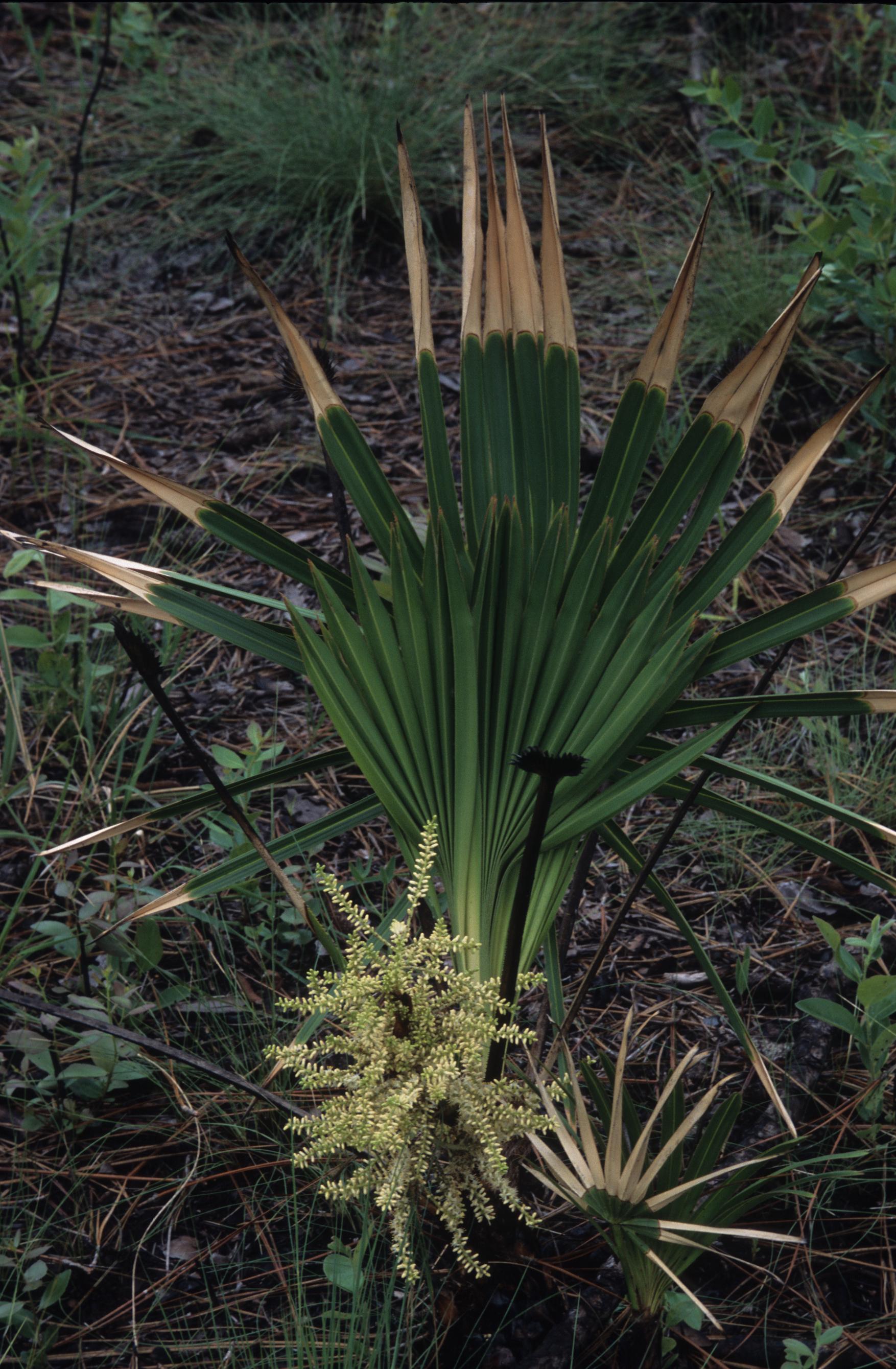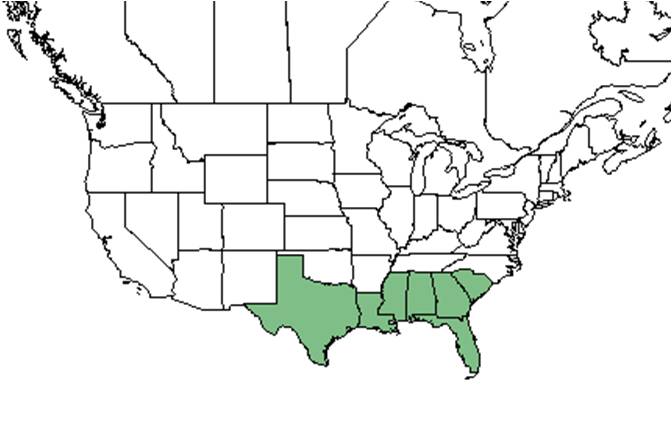Serenoa repens
| Serenoa repens | |
|---|---|

| |
| Photo taken by Gil Nelson | |
| Scientific classification | |
| Kingdom: | Plantae |
| Division: | Magnoliophyta - Flowering plants |
| Class: | Liliopsida – Monocotyledons |
| Order: | Arecales |
| Family: | Arecaceae ⁄ Palmae |
| Genus: | Serenoa |
| Species: | S. repens |
| Binomial name | |
| Serenoa repens (W. Bartram) Small | |

| |
| Natural range of Serenoa repens from USDA NRCS Plants Database. | |
Common name: saw palmetto
Contents
Taxonomic notes
The genus Serenoa honors Sereno Watson, an assistant of Asa Gray. Repens refers to the plant's creeping habit.[1]
Description
A description of Serenoa repens is provided in The Flora of North America.
S. repens has been observed to have no true stem, with petiole spinescent below surface.[2]
Distribution
This species is distributed from South Carolina to southeastern Louisiana.[3] It is one of the most abundant species in Florida.[1] Typical individuals have green leaves, however, there is a form with blue leaves that can be found along the southeastern coast of Florida.[4]
Ecology
Habitat
In the Coastal Plain in Florida and Georgia, Serenoa repens has occurred around sinkholes in oolite, on dunes in an understory of Pinus clausa, sandpine-evergreen oak scrubs, cabbage palm-hardwood hammocks, pine flatwoods, open slashpine woodlands, coastal hammocks, Baccharis flats, longleaf pine-scrub oak ridges, dried up ponds, and pine-oak woodlands. It has been found in disturbed areas such as open pastures, roadsides, and a newly planted slash pine plantation with deep sterile sandy soil.[2] It will occur on sites ranging from xeric to hydric and on soils ranging from strongly acidic to alkaline[5] and has been found on sandy loam and sand.[2] Associated species include Persea, Rapanea, Myrica, Ficus, and Ardisia.[2]
Phenology
S. repens reproduces vegetatively by sprouting from rhizomes and sexually.[6] It flowers March through June and fruits April through December.[2]
Seed dispersal
Seeds are animal dispersed.[6] According to Kay Kirkman, a plant ecologist, this species disperses by being consumed by vertebrates (being assumed).[7]
Seed bank and germination
Seedling growth and early development are slow and full establishment requires 2 to 6 years.[6] Foster (2012) agreed upon an earlier study where what was found was that seedlings showed a type 2 survivorship with a reasonably constant mortality rate. The adult individuals are extremely long lived and experience limited recruitment. In restoration sites, saw palmetto growth can be accelerated under certain conditions.[8]
Fire ecology
This species is very fire tolerant, most fires defoliate and top-kill the flammable foliage.[6] Behm states that S. repens contains the highest fine, coarse and total fuel biomass as well as the greatest accumulated debris and total energy content of the ten common Florida understory species. [9] It is able to survive fire by resprouting from a persisten root crown and rhizomes. Winter burned stands recover faster than summer burned stance because of the longer period of growth before the next winter dormancy.[6] It has been observed growing in recently burned habitats such as turkey-oak sandhills.[2]
Pollination
The following Hymenoptera families and species were observed visiting flowers of Serenoa repens at Archbold Biological Station: [10]
Apidae: Apis mellifera, Bombus impatiens, Epeolus glabratus, E. pusillus, E. zonatus,
Colletidae: Colletes banksi, C. brimleyi, C. mandibularis, C. nudus, C. sp. A, Hylaeus graenicheri
Halictidae: Agapostemon splendens, Augochlora pura, Augochlorella aurata, Augochloropsis metallica, Halictus poeyi, Lasioglossum miniatulus, L. nymphalis, L. placidensis, L. puteulanum, Sphecodes heraclei
Leucospididae: Leucospis affinis, L. birkmani, L. robertsoni, L. slossonae
Megachilidae: Megachile xylocopoides
Pompilidae: Episyron conterminus posterus, Tachypompilus f. ferrugineus
Sphecidae: Bicyrtes quadrifasciata, Cerceris blakei, C. flavofasciata floridensis, C. fumipennis, C. rozeni, C. rufopicta, Crabro hilaris rufibasis, Ectemnius decemmaculatus tequesta, E. maculosus, E. rufipes ais, Isodontia exornata, I. mexicana, Larra bicolor, Liris beata, L. muesebecki, Oxybelus decorosum, O. laetus fulvipes, Pseudoplisus phaleratus, Sceliphron caementarium, Stictiella serrata, Tachysphex apicalis, T. similis, Tachytes distinctus, T. guatemalensis, T. mergus, Tanyoprymnus moneduloides, Xysma ceanothae
Vespidae: Eumenes smithii, Euodynerus apopkensis, Mischocyttarus cubensis, Monobia quadridens, Pachodynerus erynnis, Parancistrocerus bicornis, P. salcularis rufulus, Polistes bellicosus, P. metricus, Stenodynerus beameri, S. lineatifrons, Vespula squamosa, Zethus slossonae, Z. spinipes
Use by animals
This species is very important to a variety of animals. Raccoons, foxes, rats, gopher tortoises, white tail deer, black bears, and feral hogs feed on the drupes. Saw palmetto is also used in protection and habitat for the crested caracara, Florida burrowing owls, Florida mouse, Florida sandhill cranes, and the Florida scrub jay.[6] Florida black bears are known to use saw palmetto as a protective cover when giving birth.[1]
Conservation and management
Saw palmetto is of little value to livestock forage and is considered a rangeland pest by ranchers. In order to remove excess saw palmetto, roller-drum choppers are used and pulled in tandem at offset angles or perpendicular to each other[6].
Cultivation and restoration
Saw palmetto has been used for a variety of purposes. It is a source of tannin and the fruit can be used as a treatment for benign prostatic hyperplasia or a diuretic. In WWII it was found to be an acceptable cork substitute, by processing the soft tissue from the stem[11].
Due to seedlings slow growth and establishment, it has long been dismissed in Florida restoration projects. However, Foster and Schmalzer (2012) found that saw palmetto growth in a restoration site can be accelerated under certain conditions.[8]
Photo Gallery
References and notes
- ↑ 1.0 1.1 1.2 Bennett, B. C. and R. H. Judith (1998). "Uses of Saw Palmetto (Serenoa repens, Arecaceae) in Florida." Economic Botany 52(4): 381-393
- ↑ 2.0 2.1 2.2 2.3 2.4 2.5 Florida State University Robert K. Godfrey Herbarium database. URL: http://herbarium.bio.fsu.edu. Last accessed: November 2015. Collectors: Loran C. Anderson, L. Baltzell, Walter M. Buswell, Angus Gholson, J.P. Gillespie, Robert K. Godfrey, Bruce Hansen, JoAnn Hansen, R.D. Houk, Lisa Keppner, Robert Kral, O. Lakela, S.W. Leonard, Sidney McDaniel, Richard S. Mitchell, Chas. A. Mosier, Gwynn W. Ramsey, John K. Small, Alfred Traverse, H.R. Totten, David E. Wilson. States and Counties: Florida: Calhoun, Clay, Dade, Escambia, Franklin, Gadsden, Gulf, Hernando, Jackson, Lake, Leon, Levy, Liberty, Madison, Monroe, Orange, Palm Beach, Taylor, Washington. Georgia: Thomas. Compiled by Tall Timbers Research Station and Land Conservancy.
- ↑ [[1]]Floridata. Accessed: March 15, 2016
- ↑ [[2]]University of Florida Extension
- ↑ McNab, W. H. and M. B. Edwards (1980). "Climatic Factors Related to the Range of Saw-Palmetto (Serenoa repens (Bartr.) Small)." The American Midland Naturalist 103(1): 204-208
- ↑ 6.0 6.1 6.2 6.3 6.4 6.5 6.6 [[3]]
- ↑ Kay Kirkman, unpublished data, 2015.
- ↑ 8.0 8.1 Foster, T. E. and P. A. Schmalzer (2012). "Growth of Serenoa repens Planted in a Former Agricultural Site." Southeastern Naturalist 11(2): 331-336
- ↑ Behm, A.L., M.L. Buryea, A.J. Long, and W.C. Zipperer. 2004. Flammability of native understory species in pine flatwood and hardwood hammock ecosystems and implications for the wildland-urban interface. International Journal of Wildland Fire 13: 355-365.
- ↑ Deyrup, M.A. and N.D. 2015. Database of observations of Hymenoptera visitations to flowers of plants on Archbold Biological Station, Florida, USA.
- ↑ Wilder, E. A. and E. D. Kitzke (1954). "Waxy Constituents of the Saw Palmetto, Serenoa repens (Bartr.) Small." Science 120(3107): 108-109.